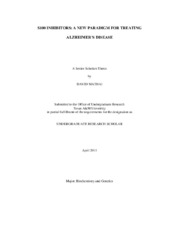| dc.contributor.advisor | Zimmer, Danna B | |
| dc.creator | Mathai, David 1991- | |
| dc.date.accessioned | 2013-06-04T16:11:14Z | |
| dc.date.available | 2013-06-04T16:11:14Z | |
| dc.date.created | 2011-05 | |
| dc.date.issued | 2011-04-27 | |
| dc.date.submitted | May 2011 | |
| dc.identifier.uri | https://hdl.handle.net/1969.1/ETD-TAMU-2011-05-9620 | |
| dc.identifier.uri | https://hdl.handle.net/1969.1/148785 | |
| dc.description.abstract | Alzheimer’s disease (AD) is the most common form of dementia, a neurological condition characterized by cognitive impairment and the inability to perform daily tasks. Neuritic protein aggregates in the brain, known as plaques, are a hallmark of AD pathology. These plaques are deposits of the amyloid-beta (A-Beta) peptide, which is derived from a larger molecule known as the amyloid precursor protein (APP). APP can be processed in one of two ways: in the non-amyloidogenic pathway, APP cleavage generates a variety of fragments that are thought to promote neuronal growth and survival; in the amyloidogenic pathway, APP cleavage leads to the production of the neurotoxic A-Beta peptide. Our lab has recently demonstrated that inhibition of two members of the S100 family of calcium binding proteins, S100A1 and S100B, synergistically reverses cognitive decline in the PSAPP mouse model of AD. However, the molecular underpinnings of this process are not known. This study tests the hypothesis that improved cognition, which is accompanied by a reduction in plaque load, is due to increased non-amyloidogenic APP processing. Western blotting was used to quantify the levels of full-length APP and A-Beta in brain lysates from 12-14 month old PSAPP and PSAPP/S100 knockout mice. APP and Aβ levels were similar in PSAPP/S100 knockout and PSAPP mice. These data suggest that the decreased pathology observed in SAPP/S100 knockout mice is not attributable to alternative processing of APP. Future directions of study include an examination of other possible mechanisms that may be responsible for observed differences in pathology. The molecular processes of plaque buildup and Aβ clearance have been proposed as targets for further study in S100 knockout mice. Once identified, this mechanistic information can be used toward the development of S100 inhibitors that improve memory loss in patients. The availability of novel pharmacological interventions for AD will significantly reduce the monetary and societal impacts of this debilitating disease. | en |
| dc.format.mimetype | application/pdf | |
| dc.subject | Alzheimer's disease, S100, APP, Aβ | en |
| dc.title | S100 Inhibitors: A New Paradigm for Treating Alzheimer’s Disease | en |
| dc.type | Thesis | en |
| thesis.degree.department | College of Agriculture and Life Sciences | en |
| thesis.degree.discipline | Biochemistry | en |
| thesis.degree.grantor | Honors and Undergraduate Research | en |
| thesis.degree.name | Bachelor of Science | en |
| dc.type.material | text | en |
| dc.date.updated | 2013-06-04T16:11:14Z | |


